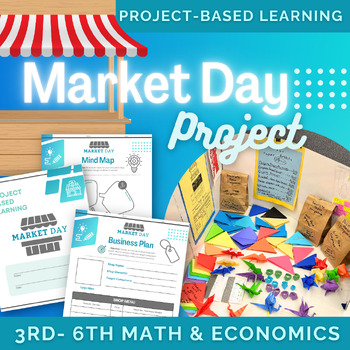Market Day Project-Based Learning (PBL): 3rd, 4th, 5th Grade Math & Economics
- PDF
What educators are saying
Also included in
- Save money and time with this DEPTH & COMPLEXITY Bundle! (Perfect for Back-to-School!) Use in 3rd, 4th, 5th, 6th + classrooms! These best-selling depth and complexity resources turn your classroom into a thriving, higher-level thinking learning environment! Want to incorporate Depth & ComplePrice $30.00Original Price $45.43Save $15.43
- Want to make the end of the school year memorable and engaging? Here are 4 end-of-year projects to do with your students that they will LOVE! Market Day, Rube Goldberg, Flower Art, and Emoji Writing. All four projects are included, as well as directions, examples, and multiple templates. These projePrice $9.79Original Price $13.98Save $4.19
Description
Here’s everything you need to facilitate a Market Day project-based learning unit for 3rd, 4th, or 5th grade! This Math and Social Studies (Economics) aligned comprehensive resource takes students through the process of creating their very own shop from start to finish. The Market Day Project-Based Learning framework sparks higher-level thinking and enrichment. Students will extend their learning of Math concepts (multiplication, division, fractions, percentages) as well as Social Studies concepts (economics, goods, services, producers, consumers, resources, etc.)
This is the perfect extension project to use at the end of a math or social studies unit, and students LOVE it!
SAVE BIG by grabbing the End-of-the-Year Projects Bundle, and get ALL FOUR of these projects for 30% off!
- Market Day
- Rube Goldberg Project
- Flower Art
- Emoji Writing
Full lesson plans, resources, printables, digital teaching slides, and bulletin board/focus wall materials are included! A full project outline is provided, however you can use the materials and activities in any way that works with your schedule.
**Want the FULL Depth & Complexity bundle with all the resources I have created? Check it out here!
Here’s what’s included:
- Student Workbook Pages
- Step-by-Step Teacher Guide
- Brainstorming Graphic Organizers
- Market Day Score Sheet
- Marketing Templates
- Family Letter
- Vocabulary Page & Posters
- Teaching Presentation Slides
- Focus Wall/ Bulletin Materials
- Enrichment Materials
- Digital Teaching Slides
- Photo Examples... AND MORE!
This is an interdisciplinary lesson which means you will be combining multiple skills across multiple subjects, so you are actually SAVING time! Plus, it is much more engaging for students! This is one of those projects that they will remember forever.
Let's connect!
Instagram: LodgesLearning
Website: www.lodgeslearning.com
Email: Janis@lodgeslearning.com







